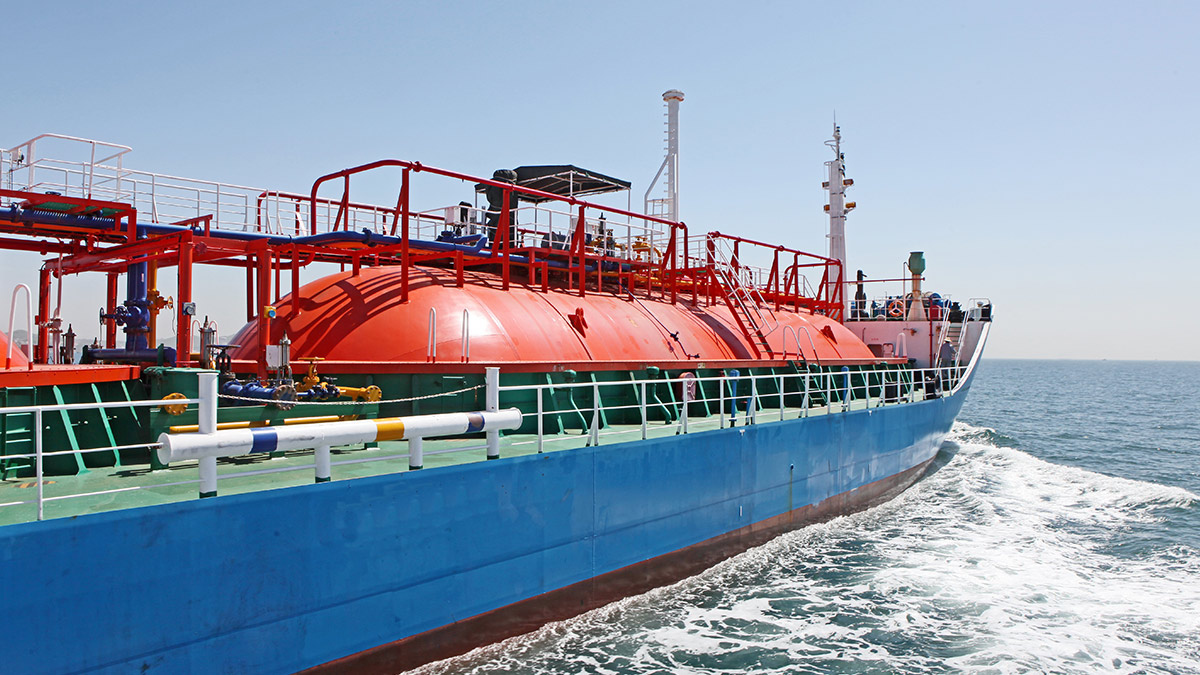Gas Stocks Guide: Here’s everything you need to know

An LNG cargo ship traverses the ocean. (Getty Images)
Natural gas is not just one of the two main hydrocarbons, it is also one of Australia’s most significant exports, reaching a record $92.8bn in 2022 on the back of strong international demand.
Said demand was caused in large part by international sanctions on Russia gas exports which in turn drove demand for liquefied natural gas cargoes and delivering record profits to Australian LNG exporters.
This also served to drive domestic gas prices soaring – particularly on the east coast, which has greater exposure to international pricing, strong demand and a continued decline in supply.
Between March and August 2022, the Australian Competition and Consumer Commission noted that the average price of supply offers from gas producers to commercial and industrial users increased by 88% to $19.77 per gigajoule compared to the previous six-month period.
However, as many higher priced supply offers were not accepted by users last year, the average price of supply contracts signed by producers increased by 30% to $12.38/GJ during this period.
Concerns about gas prices led to the Australian Federal Government imposing a $12/GJ cap on wholesale gas sales in December 2022 to the end of this year with plans to extend this by 18 months to end of June 2025.
However, the Safeguard Mechanism provides companies with production of less than 100 petajoules per year and which supply gas exclusively to the domestic market with an automatic exception to the price cap.
Prices have declined since to an average of $9.55/GJ in March, an indicator that even a $12/GJ price cap provides plenty of room for gas suppliers to enjoy economical operations.
Meanwhile, gas prices in Western Australia averaged $6.59/GJ in the December 2022 quarter due to the state’s domestic gas reservation policy.
Even this is significantly higher than it was just a couple of years ago. When the original version of this article was penned in December 2019, gas prices in the west ranged from $3 to $4 per gigajoule.
What is gas?
Like oil, gas is formed organic matter, created from the buried bodies of dead organisms such as plankton and algae, subjected to intense heat and pressure over millions of years.
The gas was then trapped in areas where permeable rocks – carbonates and sandstones that have lots of pores within them – are covered by rocks with low permeability.
Here’s how to read oil and gas announcements.
Unlike oil, which is typically a mix of different components, natural gas consists of methane – a simple molecule consisting of one carbon atom surrounded by four hydrogen atoms.
Besides its use for power generation, gas can also be used to produce fertilisers and in numerous industrial processes.
Australia has significant gas resources and is also one of the world’s largest exporters of liquefied natural gas, which is gas that has been supercooled into a liquid for efficient transport over long distances.
Investing in ASX gas stocks
With the technical details out of the way, here’s a selection of junior ASX companies with active interest in Australian gas exploration and production.
Armour Energy (ASX:AJQ)
Armour has existing gas production averaging 4.4 terajoules per day (TJ/day) in the March 2023 quarter from its assets in the Surat Basin, Queensland.
Efforts are underway to increase this output include the engagement of SLB to assist with both wells and gathering system optimisation as well as two to three fracture stimulations in the second half of 2023.
On the exploration front, the company is reprocessing 3D seismic over the Myall Creek project in the Surat Basin to identify new well targets.
It is also progressing plans to drill the Enterprise North-1 well in the Otway Basin, which targets up to 100 billion cubic feet of recoverable gas and associated condensate near the Enterprise-1 discovery that was made in 2020 and flowed gas at a stablised rate of 63 million standard cubic feet of gas per day during testing.
In the Cooper Basin, it is planning to acquire an Airborne AEM-PTP survey to assist in the imaging of hydrocarbon fluid migration pathways in the subsurface and help in planning for future exploration activity.
Armour has also reset its McArthur Basin exploration strategy with the company now expecting to appraise the Glyde gas discovery and evaluating the extents of the conventional gas play fairway and in parallel continuing to develop the unconventional shale potential of the Basin.
It already has a heads of agreement in place to supply Lucapa Diamond subsidiary Australian Natural Diamonds with about 7 petajoules of gas over the estimated 14-year life of the Merlin Diamond project.
Bass Oil (ASX:BAS)
Existing oil producer Bass Oil is looking to leverage its oil revenues to advance its gas exploration assets in the northern Cooper Basin, which may host a new Triassic gas play.
At the centre of its efforts is the Kiwi gas discovery in Ex PEL 90K that was never completed or tested despite having assessed recoverable resources of between 1.6Bcf and 5Bcf of gas.
The company is evaluating the stratigraphic upside gas trapping potential, quantifying the minimum economic potential of the structural closure, as well as the cost and feasibility of connecting Kiwi into the Cooper Basin gas gathering network.
Bass is pushing ahead to carry out an extended production test, which could provide a clear pathway for the company to enter the gas market from late 2024.
This will in turn bring infrastructure closer to PEL 182, where recent studies have highlighted a potential material new source of gas in the deep coals.
BPH Energy (ASX:BPH)
BPH has a 36.1% interest in Advent Energy whose wholly-owned subsidiary Asset Energy has a 85% interest in PEP 11, which has a best estimate prospective resource of up to 5 trillion cubic feet of gas.
A previous decision by the Commonwealth-New South Wales Offshore Petroleum Joint Authority to refuse the extension of permit’s term was found by the Federal Court of Australia to be affected by apprehended bias brought about by former Prime Minister Scott Morrison.
This led to the decision by the Joint Authority to be set aside as it will need to be remade.
Until a new decision on its renewal is made, PEP 11 remains in force and the joint venture with Bounty Oil & Gas continue to stay in compliance in regards to reporting, payment of rents and the various provisions of the Offshore Petroleum and Greenhouse Gas Storage Act 2006.
Central Petroleum (ASX:CTP)
High gas prices are a boon for producers such as Central Petroleum, which recorded sales revenue of $10.9m from sale of 1.3 petajoules equivalent in the March 2023 quarter.
Plans are already underway to deliver production increases at its Mereenie field with recompletions of five wells in progress and the drilling of two new wells later this year.
The company is also participating in the drilling of the Jacko Bore-2, Mahler-1 and Dukas-2 wells.
While these wells are aimed primarily at helium, they are also estimated to contain significant quantities of gas.
Comet Ridge (ASX:COI)
Comet Ridge holds substantial acreage in the Mahalo gas hub in Queensland’s Bowen Basin with a 100% equity in three project areas and a 57.14% stake in the Mahalo joint venture project operated by Santos.
The company is focused on adding to its Mahalo reserves and the progressing two development streams to position Mahalo North, where gas reserves have been certified, to commence supplying gas into the East Coast market from 2024/25.
These comprise field development activities such as development well planning activities and engineering studies to confirm gas compression and water handling facilities required to commence production and infrastructure access arrangements including a FEED study to transport gas to the nearby Denison compression and dehydration plant and pipeline infrastructure or progressing a standalone pipeline connection.
Mahalo currently has a resource of 406 petajoules with production capability proven by the Mira-6 lateral pilot that produced 1.4 million cubic feet of gas per day while the Mahalo North-1 pilot well flowed 1.75MMcfd.
Metgasco (ASX:MEL)
Along with its joint venture partner Vintage Energy, Metgasco enjoys gas production from the Vali gas field in the Cooper-Eromanga Basin, Queensland.
From the start of production from the Vali-1 well on 21 February to 31 March, the company recorded revenue of $179,770 from the sale of 23 terajoules of gas.
Metgasco expects long-term stable production from all Vali wells and noted that over 80% of its Vali reserves remain uncontracted.
The existing facilities at Vali are also expected to enable the joint venture to bring their Odin gas field just across the border in South Australia into production.
Vali and Odin have combined resources of 34.75 petajoules of gas net to Metgasco.
Galilee Energy (ASX:GLL)
Galilee holds one of the largest uncontracted gas resources on Australia’s East Coast with its Glenaras coal seam gas project estimated to have 2,508 petajoules of gas.
The company is currently progressing the Glenaras Pilot Field which included the drilling of the G29 multi-lateral, several vertical wells, an alternative artificial lift design, and additional “shield” vertical wells drilled between July 2022 and April 2023.
These were all required before the pilot started to exhibit signs of a coal seam gas reservoir in transition towards production – namely the reduction of reservoir pressure which is required before gas can flow.
Global Oil and Gas (ASX:GLV)
The company spent the March 2023 quarter planning future work programs including a proposed 2D seismic program to satisfy licence commitments for EP 127.
It has also prepared a plan to satisfy regulatory requirements prior to executing the field activities.
Global and its joint venture partners are also continuing to review the remaining leads in WA-519-P to prospects.
This includes an assessment of data from the Sasanof-1 exploration well which did not intersect gas reservoirs.
Omega Oil & Gas (ASX:OMA)
Omega’s goal of establishing a Permian Deep Gas play in southeast Queensland is off to a fantastic start with drilling of the Canyon-1 and Canyon-2 wells intersecting gas columns of 424m and 293m respectively in the Kianga Formation and Back Creek Group.
While there is still significant work required to determine their commerciality, laboratory analysis of mud gas samples taken from the two formations in Canyon-2 confirmed that zones of high gas saturation are present along with LPG gasses and condensate.
Further support came from wireline logging at Canyon-2, which returned better than expected interpreted porosities averaging more than 9%.
Should subsequent hydraulic stimulation and flow testing succeed, Omega could play a key role in helping to supply Eastern Australia as its tenements are independently estimated to host a Prospective Resource of 3 trillion cubic feet of gas and 233 million barrels of associated liquids.
Vintage Energy (ASX:VEN)
Besides sharing the Vali and Odin gas fields with Metgasco, Vintage also holds PEP 171 in the Otway Basin, Victoria, and 30% interests in several tenements – the Deeps – in the Galilee Basin, Queensland.
PEP 171 is prospective for gas as demonstrated by production from Penola Trough just across the state border in South Australia.
The company is currently planning for 3D seismic acquisition.
Over in the Deeps, Vintage is working with operator Comet Ridge to stimulate and flow test wells that were partly completed but interrupted by wet season and the Covid pandemic.
At Stockhead we tell it like it is. While BPH Energy and Omega Oil & Gas are Stockhead advertisers, they did not sponsor this article.
UNLOCK INSIGHTS
Discover the untold stories of emerging ASX stocks.
Daily news and expert analysis, it's free to subscribe.
By proceeding, you confirm you understand that we handle personal information in accordance with our Privacy Policy.








